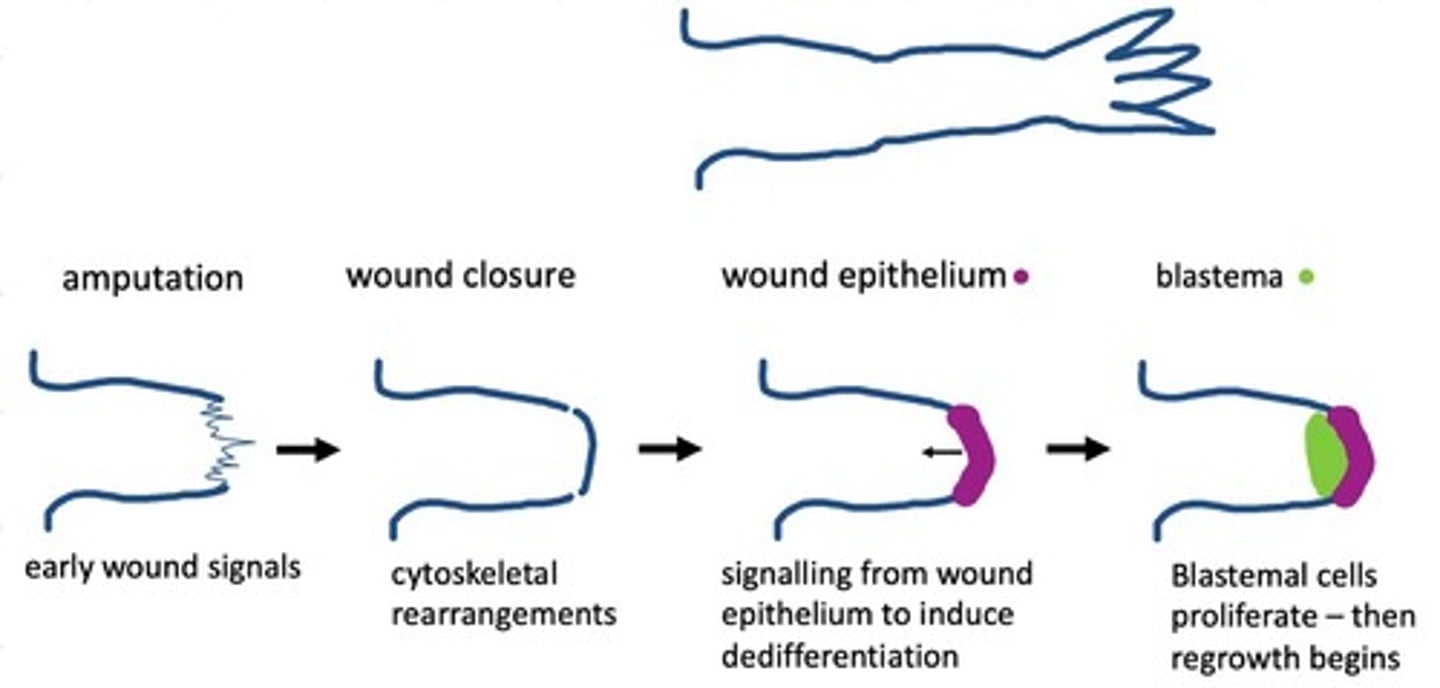L14 Regeneration (Imported from Quizlet)
1/37
There's no tags or description
Looks like no tags are added yet.
Name | Mastery | Learn | Test | Matching | Spaced |
|---|
No study sessions yet.
38 Terms
What is regeneration?
The ability of organisms to restore their structures in form and function
________ vertebrats have more regenerative capabilities than __________ vertebrates (limb, eye, spinal cord, heart)
Aquatic, terrestrial
Simple organisms have a remarkable ability to ___________ (whole body)
Regenerate
Regenerative biology plays a role in ...?
Homeostasis, development, wound healing, regenerative medicines senescence (process of ageing), inflammation (inflammatory cells guided to damaged tissue), stem cells
Hydra uses ___________ (more posterior, head)
Morphallaxis
Salamander uses __________ (more anterior, tail)
Epimorphosis
When you cut an organism to remove part of it, what do you have to restore?
Missing tissue
What does morphallaxis do?
Takes existing tissue and re-patterns, creates a smaller organism
What does epimorphosis do?
Posterior cells will proliferate, lay out and regain the missing tissue, same size as the original before you cut it
Wounding causes an ...?
Immediate wound response
What are the early wound signals?
ATP is released by damaged cells, intracellular calcium is elevated, relative oxygen (H2O2) is released
These molecules act as _______ over the first few minutes to initiate the ______ response
Signals, wound
How does wounding initiate regeneration?
Fibrosis (scarring) is permanent and caused when fibroblasts secrete high levels of extracellular matrix (collagen, etc)
What is the wound response?
Causes cytoskeletal changes to close the wound, the cells on the edge will form pure strings to close the wound if it is small enough
Immune cells are recruited to the site
Initiates regeneration or scar formation
Salamander regrowth begins once __________ has formed, _____________ occurs and pushes ______ out to regenerate the limb entirely
Blastema, proliferation, distal

_________ __________ is thicker than the surrounding skin and is known to secrete _________
Wound epithelium, signals
What is the first sign that regeneration has begun?
Formation of the wound epithelium
The blastema is formed by cells that ...?
Dedifferentiate (partially)
Dedifferentiation to the point where cells still have their ________, they are not turning into ___________ cells
Identity, multipotent
What is the minimum size of fragment that can regenerate?
1/279th (0.3%)
What are neoblasts?
Adult stem cells of planaria
Where are neoblasts located?
Scattered throughout the animal
Head regeneration in planaria involves what?
Epimorphosis
Regeneration from small fragments results in small animals, what kind of regeneration is this?
Morphallaxis
Some neoblasts are ___________ (differentiate into many different cell types), others are ________ ___________ (only same cell type)
Pluripotent, lineage restricted
What is a hydra?
Simple animal with two germ layers and adult stem cells called interstitial cells
Hydra's are continually _________ due to the __________ ______ and reproduce by ___________
Growing, interstitial cells, budding
Cell division and interstitial cells are not required for regeneration -> ?
Morphallaxis
Wnt signals from the hypostome are able to induce what?
Bud formation
Stem cells in hydra don't contribute to regeneration, interstitial cells aren't __________ they don't ____________ to repair the tissue
Activated, proliferate
If 20% of the ventricle of an adult zebrafish heart is removed, what happens?
It will regrow
Wounding in a zebrafish causes activation of _________ -> a thin layer of cells that encapsulates the skin of the heart
Epicardium
What does activated epicardium secrete?
Retinoic acid (a signal), IGF2 (induce mitosis) and hedgehog signals
What are these signals secreted by activated epicardium required for?
Regeneration
_______________ (muscle cells) dedifferentiate and proliferate at the wound site
Cardiomyocytes
Vascularisation take place and the regenerated cardiomyocytes become active which results in ...?
A heart with a scar
What do humans regenerate?
Bone, skin, muscle and liver
Could we harness the power of endogenous regenerative mechanisms?
BMP2 soaked beads induce skeletal regeneration from digit and limb amputations
BSA is not a signal but BMP2 is
This is more dramatic with hind limbs